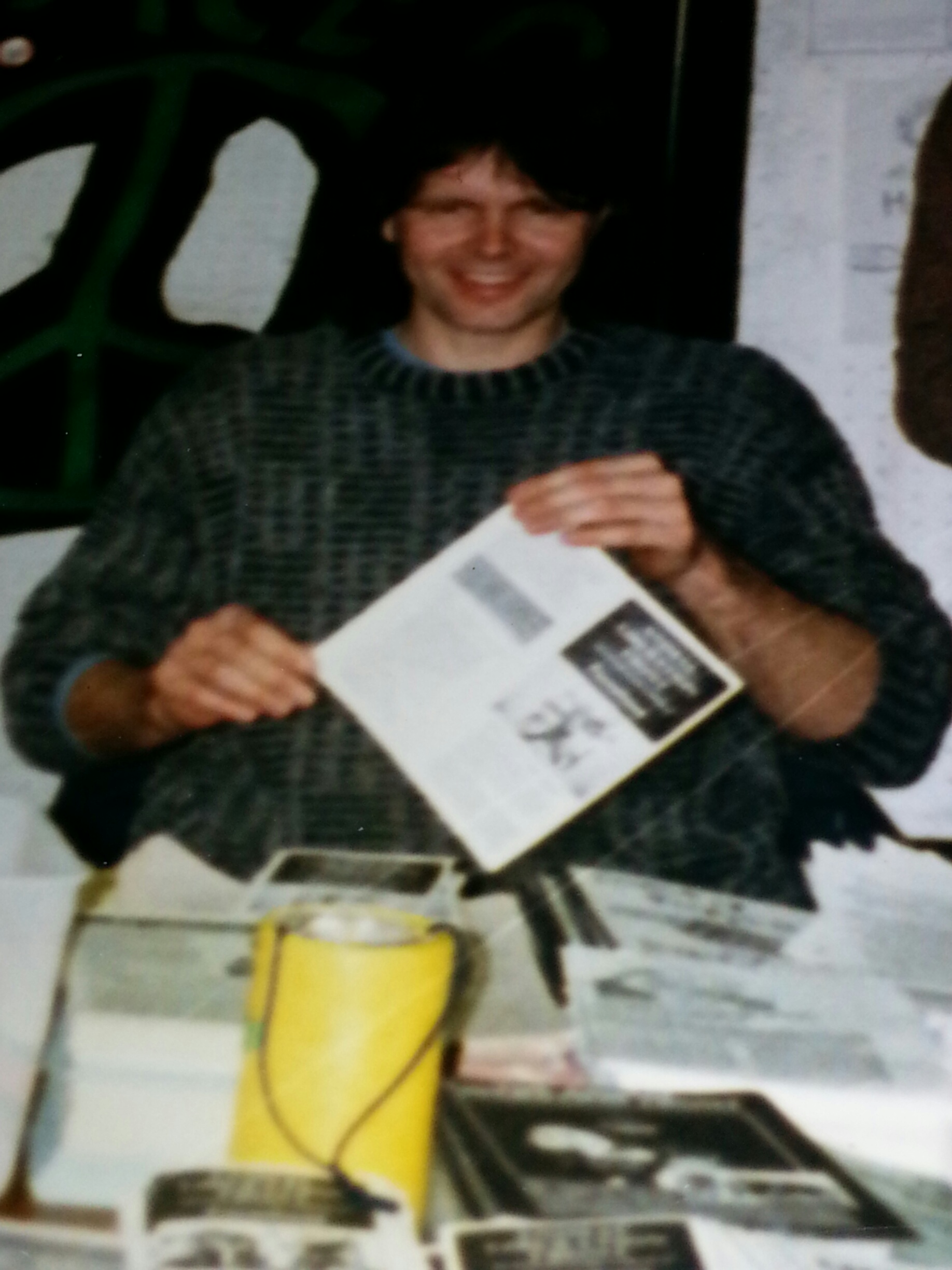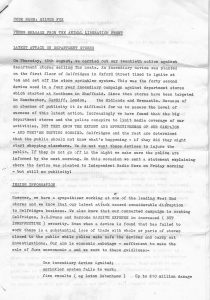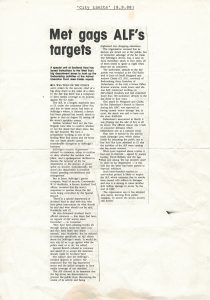
Bob Lambert used the alias Bob Robinson to infiltrate animal rights, environmental and anarchist groups in the 1980s. To those who knew him, myself included, he was charismatic and dedicated and carried out direct action before fleeing the country to evade the police.
In the past five years we have learnt a lot more about him. He never went abroad, instead he continued working for Special Branch and in 1993 was appointed operations manager of the Special Demonstrations Squad to supervise other spies.
After he retired from the Met in 2007, Lambert pursued a second career as an academic specialising in Islamophobia and de-radicalisation in the wake of 9/11 and 7/7. He was outed while speaking on this subject at a conference in October 2011.
Much has been written about his deployment due to research by activists, journalists and organisations such as the Undercover Research Group. Lambert also spoke about it during a televison interview.
He began infiltrating protest groups in 1984 and over the next four years was a leading figure in London Greenpeace and the animal rights movement. In 2011 Geoff Sheppard and Andrew Clarke accused him of being part of an Animal Liberation Front cell which attacked Debenhams stores for selling fur coats.
Until now it was thought Lambert’s career as an ALF activist ended with the arrest of Geoff and Andrew in 1987. But what if he didn’t stop there? What if he continued to target department stores with incendiary devices? Evidence has emerged which indicates this was may indeed be the case.
Lambert’s ALF press release

By the summer of 1988 two ALF press officers were serving prison sentences, as were several other activists. The ALF Supporters Group was feeling the strain and as a result I agreed to help by collecting its post and answering letters.
In late August I was alone in the London Greenpeace office near Kings Cross. The group was organising an Anti-McDonald’s Fair and I was busy with that. I recall Lambert turning up and telling me to expect a press release from the ALF because he had planted an incendiary device in Selfridge’s department store a few days earlier.
A day or two later the press release arrived, in a typewritten envelope addressed to the ALF Supporters Group and postmarked London N1 30 Aug 1988. It is four typewritten pages long, dated 29.8.88 and headed: “CODE NAME: SILVER FOX. PRESS RELEASE FROM THE ALF. LATEST ATTACK ON DEPARTMENT STORES.”
The device, it says, was planted on the first floor of Selfridges in Oxford Street “timed to ignite at 1am and set off the store sprinkler system:”
This was the 42nd device used in a four year incendiary campaign against department stores which started at Rackhams in Sheffield. Since then stores have been targeted in Manchester, Cardiff, London, the Midlands and Newcastle. Because of an absense (sic) of publicity it is difficult for us to assess the level of success of this latest action. Increasingly we have found that the big department stores and the police conspire to limit media coverage of our activities. BUT THEY KNOW THE EXTENT AND EFFECTIVENESS OF OUR CAMPAIGN – AND THEY’RE GETTING WORRIED.
Lambert claims a “sympathiser working at one of the leading West End stores” has divulged the latest attack caused “considerable disruption” to Selfridges and huge costs due to “increased but ineffective security.”
He then lists different levels of economic damage, from up to £10m when a device ignites and the sprinker system fails, resulting in a major blaze, through the sprinkers working (up to £1m), to when the device doesn’t work and is found by the shop or the police and the store evacuated (up to £20,000 damage).
Fur traders have been “very busy behind the scenes” trying to keep their products in Selfridges by compensating them for losses due to direct action. He adds: “We will not go away – our attacks will persist until the furs supplied by Edelsons are removed form your floor space.”
Then he turns to “brave and selfless” Geoff Sheppard and Andrew Clarke. They had just been sentenced for conspiracy to commit arson against Debenhams but are now appealing against their convictions saying they were set up by Lambert. Ironically he says: “We take strength form their courage and dignity. AND WE ARE MORE DETERMINED THAN EVER THAT THEIR EFFORTS WILL NOT BE WASTED.”
The next section – Caution and Commitment – talks about tightening security, learning from mistakes, warns “the quality our incendiary devices is improving” and threatens “new tactics” that will “strech (sic) the stores security still further.”
Lambert’s next rails against “top peoples store” Harrods, claiming it was “treated to the sprinkler system treatment” which he does not believe only caused minor damage: “If the police had been able to arrest anyone for the attack then we would certainly have found out the true cost of the damage.”
It isn’t just the fur trade either, and in the next paragraph Lambert refers to a forensic scientist at Geoff and Andrew’s trial who said she had examined over 100 incendiary devices in the last three or four years and was “FULLY EMPLOYED WORKING ON OUR ATTACKS”. He warns: “Our attacks on the meat trade and the vivisection industry will be stepped up” and “we also attack the brutal bloodsport empire. Combined with the efforts of hunt saboteurs we expect to see success in this area at about the same time as the anti fur campaign scores a victory.”
Next comes “The Puzzle” – in the last four years activists have received sentences totalling over 100 years and “we are only too painfully aware that the courts and police take our actions seriously”. Yet, claims Lambert, the media is deceiving the public with a smokescreen – “ARE THEY UNDER PRESSURE FROM THE ESTABLISHMENT? DO THEY JUST REPORT CRIMES THAT THE POLICE FEED THEM…Is the name of a ROYAL BABY so much more important.”
This is the final paragraph.
THE WARNING
Make sure the sprinkler systems are kept well maintained at Selfridges, D.H. Evans and Harrods (and any other department stores selling furs). If they’re not we might achieve our target quicker than expected.
City Limits
It wasn’t just the ALF SG who received the press release. The next edition of radical listings magazine City Limits contained a story titled “Met gags ALF’s targets” in which reporter Sean O”Neill said: “A special unit at Scotland Yard has issued instructions the West End’s big department stores to hush up the firebombing activities of the Animal Liberation Front.”
Head of security, Commander W.H. Hucklesby, a “former Scotland Yard officer” is quoted saying the store’s responses to queries about the ALF were controlled by Special Branch: “There is a special department at Scotland Yard to deal with this, who have given instructions on what should be said and what should not be said.”
He also said the ALF had been “planting bombs all through Oxford Street for years” but refused to confirm or deny the claim made by Lambert. Special Branch themselves declined to comment and pointed CL towards a statement already made by Scotland Yard that would not confirm the attack. The article also states:
Selfridge’s security department refused “to comment, earth to confirm or deny whether the incident took place” and a spokesperson declined to discuss the turnover of the fur department or the amount of money spent on security. Coincidentally the store’s fur department is presently closed “pending refurbishment and enlargement”.
The article continues by summarising the press release and quotes Lynx as “admitting to CL that the activities of ALF were causing the big stores concern”. A letter the anti-fur group had recently sent to Harrods asking it close its fur salon had been passed to the store’s solicitor.
The report concludes by saying that such “heavy-handed” tactics are likely to “inspire the ALF, which estimates that its attacks have caused £20 million in damages and says it is aiming to cause another another £10 million damage to stores ‘by the end of 1989’.”
Stranger than fiction?
Lambert – dubbed “the slippery fox” by Guardian journalists Rob Evans and Paul Lewis in their book Undercover – is a master manipulator for whom “lying comes as easily as breathing”. How then can we disentangle truth from fiction?
It’s important to look at these events against the backdrop of Lambert’s deployment, which was nearing its end. His “tour of duty” had reached its climax with the arrest and imprisonment of Geoff and Andrew and his exit-strategy was set in motion. So what part did Selfridges play in that?
I absolutely trust Geoff and Andrew’s claim that Lambert was part of their ALF cell and placed an incendiary device at the Harrow store in July 1987. He was an implacable supporter of direct action and animal liberation and while this was integral to the persona he invented, he also took pleasure from it. That’s what made him such a good undercover cop; he wasn’t just pretending to be an activist, while with us part of him was Bob Robinson.
Therefore I wouldn’t discount the possibility he did what he claimed. It’s hard to believe he would risk everything by committing a serious crime just as his undercover career was ending but he might not have been able to resist one last adrenaline rush. Here, after all, was a man who loved the life of a subversive and renegade that he had created.
Regardless of whether he did it, claimed responsibility for someone else’s work, or made the whole thing up, Selfridges was crucial to Lambert’s departure. He would already know what form it would take – fleeing abroad from Special Branch – and this action was important in confirming that. When his flat was “raided” by the anti-terrorist squad a couple of months later, everyone assumed it was for Debenhams. He no doubt wanted me to spill the beans, thereby reinforcing his cover as as fugitive on the run – but I didn’t. Loyal to my friend and comrade, I never said a word as far as I can remember. The press release was filed away and forgotten until recently.
Reading it again after so many years brought back memories of that meeting one day in August 1988 and proves how adept he was balancing the tightrope between Bob Lambert spycop and Bob Robinson activist. The reference to a cover up and conspiracy between “big department stores and the police” is based on the inside knowledge of a state agent. With hindsight it’s obvious and dropping little clues like that was a characteristic of his.
SDS officers’ deployments were meant to wind down in the last few months before they vanished. They would go to fewer protests and meetings as, typically, they were replaced by a colleague. In the case of London Greenpeace the new recruit was John Dines, aka Barker, who joined the group fully a year before his predecessor left.
Lambert, as we know, was no normal spy. Not like him to go quietly or fade into obscurity. Perhaps Selfridges was his parting shot to the world? How can we be sure three decades on? The press release says a statement “explaining where the device was planted” was sent to Independent Radio News the following morning but it’s unlikely to have survived, even if it ever existed. Scotland Yard should have a file listing ALF attacks on department stores. This one could be on it. There is an ongoing police investigation into Lambert’s role in Debenhams, Operation Sparkler, due to end by the middle of this year.
There is no proof that Bob Lambert set off an incendiary device in Selfridges on Thursday 18 August 1988 but evidence suggests he may have. The answer to the question, “did Lambert stop at Debenhams?” has to be “maybe not.”

Leave a Reply